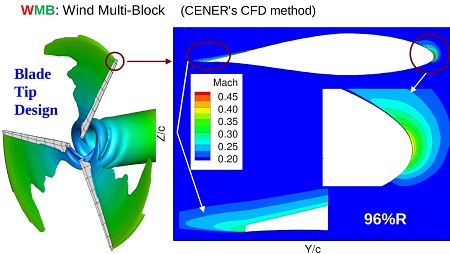ACADEMIA
CENER designs next-generation offshore wind turbines using the supercomputing power of CESGA
· The cutting edge design elements have a high computational cost, making collaboration of supercomputing centers as CESGA indispensable.
· One of the specialties of the Department Wind Energy National Renewable Energy Center of Spain, CENER is the dynamic simulation of offshore concepts.
The installation of offshore wind turbines to harness the strong winds and avoid inconvenience that may result on land is a reality, but their adaptation to this medium is new challenges. The Department of Analysis and Design of Wind Turbines (ADA) at the National Renewable Energy Center of Spain (CENER) is already working on this line, counting on their research with the calculation ability of the Supercomputing Center of Galicia (CESGA).
"The outlet to the sea of wind turbines has been creating ever larger machines, partly because its high cost of maintenance," explains CENER researcher Sugoi Gomez-Iradi, who recalls that "Initially, no offshore wind turbines were simply scaled on the ground without scaling the turbine, today the yield is very poor, so they seek new solutions. One that is being developed is to increase the speed of rotation of the blades to capture more air and thus more energy: this is more difficult to implement on land because the increasing the rotational speed also increases the noise."
CENER’s Sugoi, Gomez-Iradi says, "Is very well positioned in this regard to develop methods to model the turbine and support of sea-floating or fixed, and we have a development tool with the University of Liverpool, called WMB, a method computational fluid dynamics (CFD) that is compressible and extensively validated for wind turbines. "
One of the problems facing the design of offshore wind turbines is that of compressibility, a property of matter which is that all bodies must decrease volume when subjected to a pressure. In the case of wind power installations "Is considered that the effects of compressibility of air should be taken into account when its speed is close to 100m / s (~ 0.3 Mach) but also involves lower speeds. Moreover, this speed is increased locally " said the researcher.
"The calculations required for design, for example, rotor blade tips, have a high computational cost, and CESGA centers like in combination with the right tools can make your resolution," he concludes.

More Info:
sgomez (at) cener.com
Links a publicaciones especializadas:
a) S. Gomez-Iradi and X. Munduate
A CFD Investigation of the Influence of Trip-Tape on the MEXICO Wind Turbine Blade Sections 'The
Science of Making Torque from the Wind', June 2010
b) Simon-Philippe Breton, Christophe Sibuet Watters, Christian Masson, Sugoi Gomez-Iradi, Xabier
Munduate
On the prediction of tip vortices in the near wake of the MEXICO rotor using the actuator surface method
International Journal of Engineering Systems Modelling and Simulation 2012 - Vol. 4, No.1/2 pp. 11 – 26,
DOI: 10.1504/IJESMS.2012.044840
http://www.inderscience.com/search/index.php?action=record&rec_id=44840&prevQuery=&ps=10&m=or
c) S. Gomez-Iradi, R. Steijl and G.N. Barakos
Development and Validation of a CFD Technique for the Aerodynamic Analysis of HAWT
J. Sol. Energy Eng. - August 2009 - Volume 131, Issue 3, DOI: 10.1115/1.3139144
http://dx.doi.org/10.1115/1.3139144
